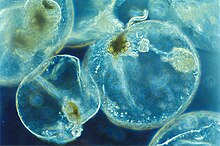Noctiluca scintillans
| Noctiluca scintillans | |
|---|---|

| |
| Scientific classification | |
| Domain: | |
| Order: | |
| Family: | |
| Genus: | Noctiluca
|
| Species: | N. scintillans
|
| Binomial name | |
| Noctiluca scintillans (Macartney) Kofoid & Swezy, 1921 | |
| Synonyms | |
|
Noctiluca miliaris | |

Noctiluca scintillans, is the sea sparkle.[1] It is a free-living marine-dwelling species of dinoflagellate.
It shows bioluminescence when disturbed: this produces a "milky seas effect". The bioluminescence is produced in the cytoplasm of this single-celled protist. It is done by a luciferin-luciferase reaction in thousands of spherical organelles, called scintillons. Nonluminescent populations in the genus Noctiluca lack these scintillons.
Noctiluca is a heterotroph (non-photosynthetic) that engulfs by phagocytosis. They eat plankton, diatoms, other dinoflagellates, fish eggs and bacteria. The diatom Thalassiosira is known as a favourite food source of Noctiluca.
N. scintillans also takes in tiny phytoplankton which live as endosymbionts. They do photosynthesis for their larger host. Diatoms are often found in the vacuoles (internal membrane-bound storage compartments) of Noctiluca. The green non-feeding symbionts can grow photoautotrophically for generations.[2]
References[change | change source]
- ↑ "Iimage of the "Sea Sparkle" from 'Britannica Online Encyclopedia'". Britannica.com. Retrieved 2013-09-13.
- ↑ Saito, Haruna, Ken Furuya & Thaithaworn Lirdwitayarpasit 2006. Photoautotrophic growth of Noctiluca scintillans with the endosymbiont Pedinomonas noctilucae. Plankton & Benthos Research 1: 97–101
